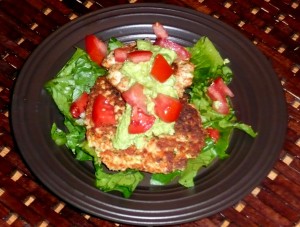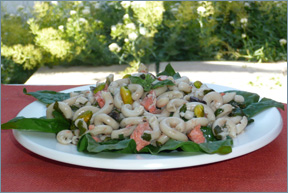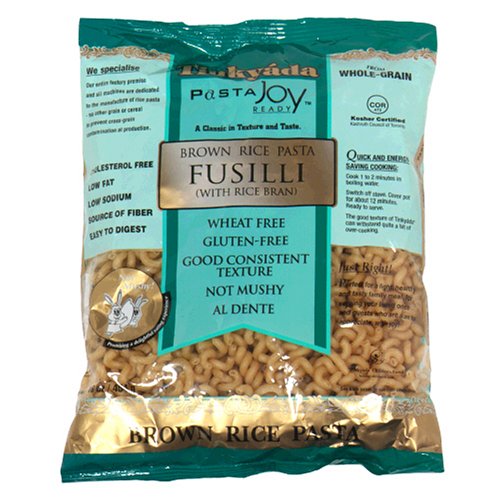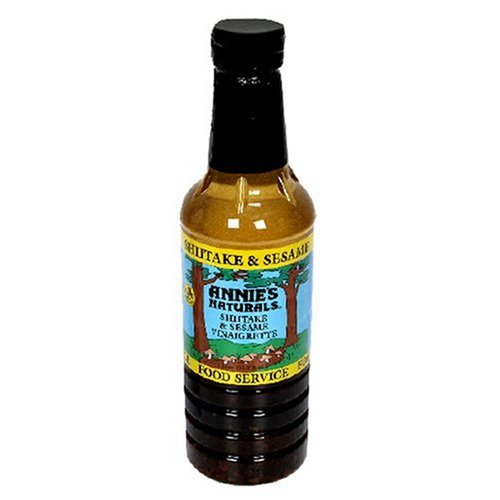Tag: salmon
Fresh Salmon Burgers with Quinoa (Gluten-free)
There’s a guy at the farmer’s market in my neighborhood who sells frozen wild-caught, vacu-sealed, Alaskan Salmon steaks and fillets. This weekend I purchased a two-pounds of salmon filets; half of which we broiled and ate that night with farm-fresh organic green beans and organic garlic mashed potatoes.

Last night, I wanted to do something different with the second pound of delicious wild salmon, so I made gluten-free salmon burgers.
My family tries to avoid eating farm-raised salmon whenever possible. Farm-raised salmon is more affordable because the fish are raised unnaturally in pens, fed soy- or corn-based feed pellets (not their natural diet), liberally dosed with antibiotics and anti-parasitic drugs (necessary due to the close quarters), and fed dye to tint their flesh pinkish like their wild cousins’.
If we see salmon on a restaurant menu and it is not preceded by the adjective “wild,” we do not order it. If a restaurant has salmon on the menu for less than $17, you can be sure it is farm-raised fish.
Even worse, Genetically Modified salmon may be approved by the FDA and these unlabeled, untested-on-humans frankenfish could end up on your plate without you even knowing it.
Wild salmon, on the other hand, can live for years swimming through the oceans and then make a final migration up-river, fighting the current as they swim upstream to spawn where they were born. Their flesh is developed from activity, not unfamiliar proteins; they do not need antibiotics or other drugs to keep them healthy; and their flesh is naturally pinkish-colored from their natural diet in the sea.
After surveying a number of salmon burger recipes for inspiration, I started cooking my own recipe. I wanted to make them gluten-free, so I substituted quinoa flakes for the bread crumbs. How did it turn out? Loved by everyone!
PS: I call these “Fresh Wild Salmon Burgers” because many salmon burger recipes use canned salmon.
[print-me target=”.recipe”]
Fresh Wild Salmon Burgers with Quinoa (Gluten-free)
- 2 eggs, beaten
- 1 medium zucchini
- 2 tsp. horseradish
- 1 Tbsp. basil, chopped
- 1/2 tsp. sea salt
- Freshly cracked black pepper
- 1 lb. skinless salmon
- 3/4 cup quinoa flakes
- Coconut oil
- Toasted sesame oil
Beat the eggs in a medium mixing bowl until blended.
Trim the ends and quarter the zucchini. Pulse quarters in a food processor until diced. Add to the bowl of eggs with horseradish, basil, salt and pepper.
Cut the salmon into large chunks and pulse in the food processor until diced (do not process into a paste). Add to the egg-zucchini mixture and mix in quinoa flakes to make a mixture that will hold together in patties.
On a cast iron griddle or skillet, heat 1 Tbsp. of coconut oil with 1 tsp. of sesame oil. Place the patties into the oil, flipping when needed until cooked through.
Serve with mashed avocados with sea salt and sliced tomatoes on a bed of lettuce or on a bun.
Quick and Easy Gluten-free Dinner from Leftovers
Last weekend we grilled wild-caught Alaskan salmon on a cedar plank alongside some asparagus rubbed with olive oil. As scrumptious as it all was, we still had some leftover the next day for me to incorporate into another dinner. I decided to incorporate the leftovers into a pasta salad and make it all new again.
I boiled some fusilli pasta (we used Tinkyada rice pasta because our house is mostly wheat-free due to my son’s food sensitivities, but you can use any kind of pasta you prefer). When it was al dente tender, I drained and rinsed it with cold water in a colander.
Meanwhile, I had washed and chopped a bunch of fresh spinach that was waiting in a large bowl. Into the bowl, I also added the remainder of the cedar-planked salmon and grilled asparagus, cut into bite-sized pieces. I dumped the still-warm pasta on top and covered it all with a pot lid so that the spinach would wilt a bit.
I shredded some fresh basil leaves from the plant in my garden and chopped up the last few mushrooms left from earlier in the week.
As a crowning ingredient, my daughter suggested we toss in about 1/2 cup of shelled pistacio nuts. Why not, I thought. We dumped the nuts in.
 Now it was the moment of truth: what should we flavor our pasta salad with? I like to use a vinaigrette with a pasta salad, but should it be Italian, Pomegranate Chipolte, Roasted Red Pepper, or Shitake-Sesame? Annie’s Natural Shitake- & Sesame Vinaigrette, always a crowd pleaser, won the vote.
Now it was the moment of truth: what should we flavor our pasta salad with? I like to use a vinaigrette with a pasta salad, but should it be Italian, Pomegranate Chipolte, Roasted Red Pepper, or Shitake-Sesame? Annie’s Natural Shitake- & Sesame Vinaigrette, always a crowd pleaser, won the vote.
I poured it on and tossed it up. The spinach had wilted nicely from the heat of the pasta, and everything married together beautifully. The pistacio nuts turned out to be the surprise favorite – a nice touch of crunch to the salad!
My 7-year old son has decided of late that he doesn’t “like leftovers,” regardless of how eagerly he cleaned the plate of the same food a day or two before. Luckily, a pasta salad can be a great way to incorporate leftovers and not call them “leftovers” anymore! Here’s another fun pasta salad recipe to try!
“Good For You” Food Myths
Here are some foods that people think are good for them that are really anything but healthy. They’re not the only ones, of course, but perhaps they will surprise you.
1. Yogurt. I’m always surprised that people think of yogurt as a healthy food that’s helpful to eat if you want to lose weight. Our American yogurt is loaded with sugar in the flavorings or fruit added. Truly, it’s much more of a dessert than a main course. Sure, there are probiotics that are good for gut health, but the sugars can spike insulin levels, and there are better ways to get bio-absorbable calcium. Besides, no matter what the dairy lobby would like you to believe, even “fat-free” dairy products are not the dieter’s friend! Personally, I find that eating dairy products is the fastest way to pack on some extra pounds in the blink of an eye.
2. Diet sodas and diet drinks like Crystal Lite. A recent study of over 8,000 women conducted by the University of Austin, TX, concluded that those who drank diet sodas gained more weight over the course of almost a decade than those who don’t. They theorized that the problem lies in the artificial, highly concentrated, and synthetic sweeteners (aspertame, Splenda, etc.) that fool the body into producing insulin and other hormones to digest the sweet flavor, and treat the material as potent sugars that need to be stored in fat cells. Because the body can’t identify these foreign substances, the proper digestive processes are thwarted, and even though these drinks are billed as “low-calorie” or “calorie-free” they should really be called “toxic” and should be considered the antithesis to any health or weight-loss goal!
3. Salmon. Let me specify: any salmon that is not labeled as “wild”, which means that it was farm-raised. Farm-raised salmon — basically any salmon that you pay less than $40/lb for — is not really salmon at all. These genetically-modified fish are grown in over-crowded pens and often fed antibiotics and antiparasitic drugs to combat plagues like sea lice, a scourge of too many fish living too closely together under unnatural conditions. To make their flesh appear pinker and more like the salmon filets we expect, they are often fed dyes which may or may not be hazardous to our health (the jury is still out on that one, regardless of the how heavily the FDA has been lobbied by the salmon aquaculture industry). Some of these mutant fish inevitably escape from their pens and breed with wild salmon populations, weakening and contaminating the remaining schools of wild salmon, which are already disappearing from their native rivers at rates never before seen in this country. But back to how healthy it is to order the $12 salmon filet entree at your local Bennigan’s: expect to get prescription drugs, potentially carcinogenic dyes, and/or genetically-modified cells with your bargain plate.
Many of these toxins are bio-accumulative, and can collect in your cells. Depending upon an individual’s level of tolerance and/or amounts of exposure, constant doses of these foods may result in cancers, food allergies, or even auto-immune diseases, as I believe happened in my case with my own diagnosis of multiple sclerosis and 3 years of hives.
This is a topic I speak about frequently as I tour around the country helping people learn how to eat healthier. My latest cookbook arrives in stores nationwide this week. See more about my healthy eating philosophy.

